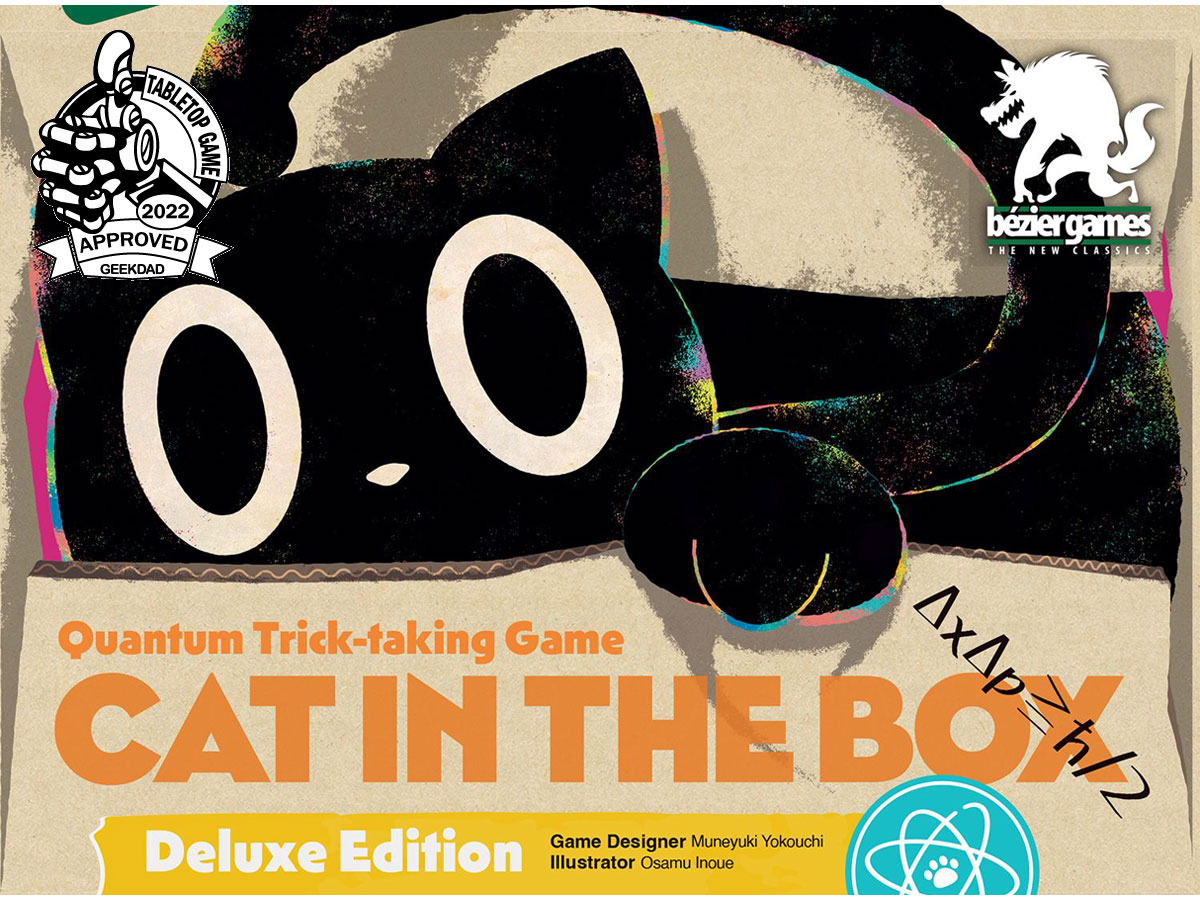What color are the cards in your hand? Nobody knows—until they’re played!
What Is Cat in the Box: Deluxe Edition?
Cat in the Box: Deluxe Edition is a trick-taking game for 2 to 5 players, ages 14 and up, and takes about 30 minutes to play. It retails for $29.95 and is available in stores and directly from the publisher. Although the box says 14 and up, I think younger players who are familiar with trick-taking games would be able to learn this as well; there’s nothing inappropriate in the theme.
Cat in the Box was designed by Muneyuki Yokouchi and published by Bezier Games, with illustrations by Osamu Inoue. (The original, non-deluxe version of this game was released by the Japanese publisher Ayatsurare Ningyoukan.)
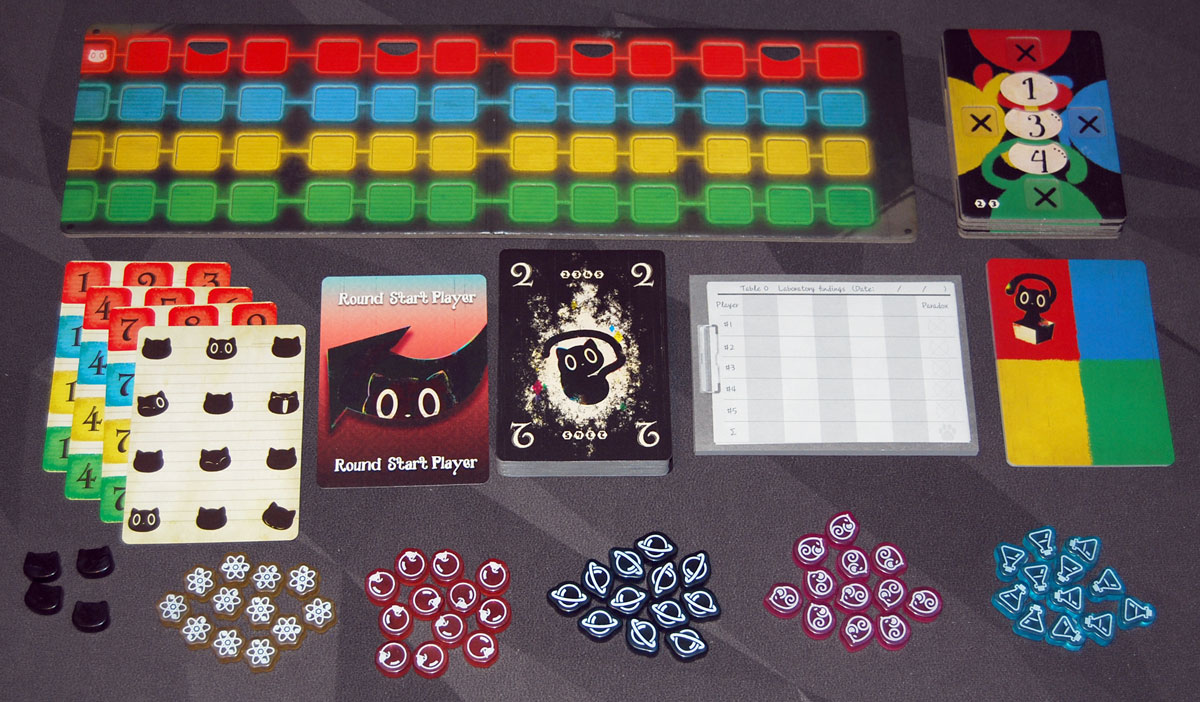
Cat in the Box: Deluxe Edition Components
Here’s what comes in the box:
- Cat (maybe)
Okay, but really:
- Research board
- 4 Research cards
- 5 Player boards
- Round Start Player card
- 45 Cat cards
- Scorepad
- 5 Player cards
- 4 Observed tokens
- 60 Player tokens (12 each in 5 colors)

The research board is a small folding board, dual-layered so that the research cards can be slotted into it, revealing the various numbers and colors on the cards. The cards are double-sided and you use either the white or purple side depending on player count and experience level. The “observed” tokens are small black cat heads, and are used to cover up unused spaces based on player count.

The player boards are actually triple-layered: it’s a card-sized board that has a side for 2–3 players and a side for 4–5 players. Each side has three small wells for your bids, and four “X” spaces to place player tokens. There are also player cards included—these are just cards, with the four corners representing the four suit colors (red, green, yellow, blue), and presumably are from the non-deluxe edition. You won’t need them, though I suppose if you wanted to ditch the boards and just take the cards for portability, these would save you a little bit of space.
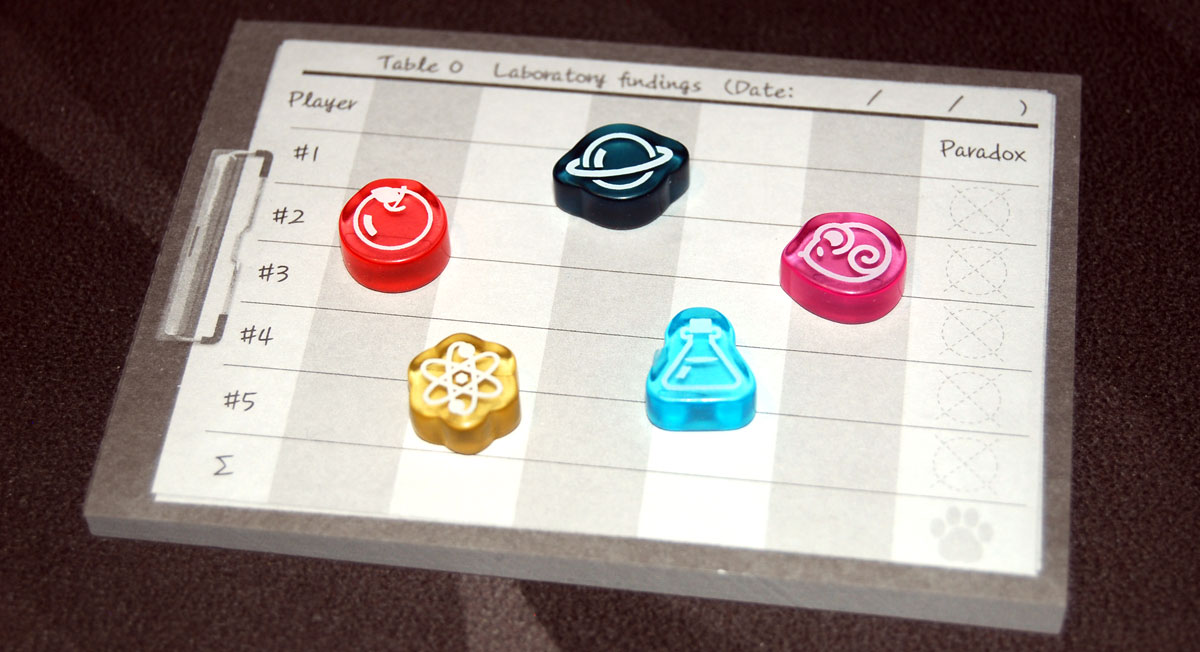
The player tokens themselves are small plastic shapes with various science-themed icons: planets, mice, flasks, atoms, and apples. They’re pretty cute, and the cloudy translucent material makes them look a bit like gummy candy. I found the pink and the orange to be kind of close in color depending on the lighting, and though they’re slightly different shapes it could be easy to get them confused if you’re not paying attention.

The cat cards themselves are numbered from 1 to 9, and each card also has some indicators for player count. The cards are primarily black and white, with little flecks of all four suit colors throughout, and each is illustrated with a small black cat.

I will note that the card backs in the game are not entirely uniform, which is kind of a surprising issue to run into. The color varies quite a bit from the lightest to the darkest. However, glancing through the cards, there doesn’t seem to be any pattern to which numbers are lighter or darker, so this information shouldn’t really affect the gameplay—it’s just aesthetically odd.
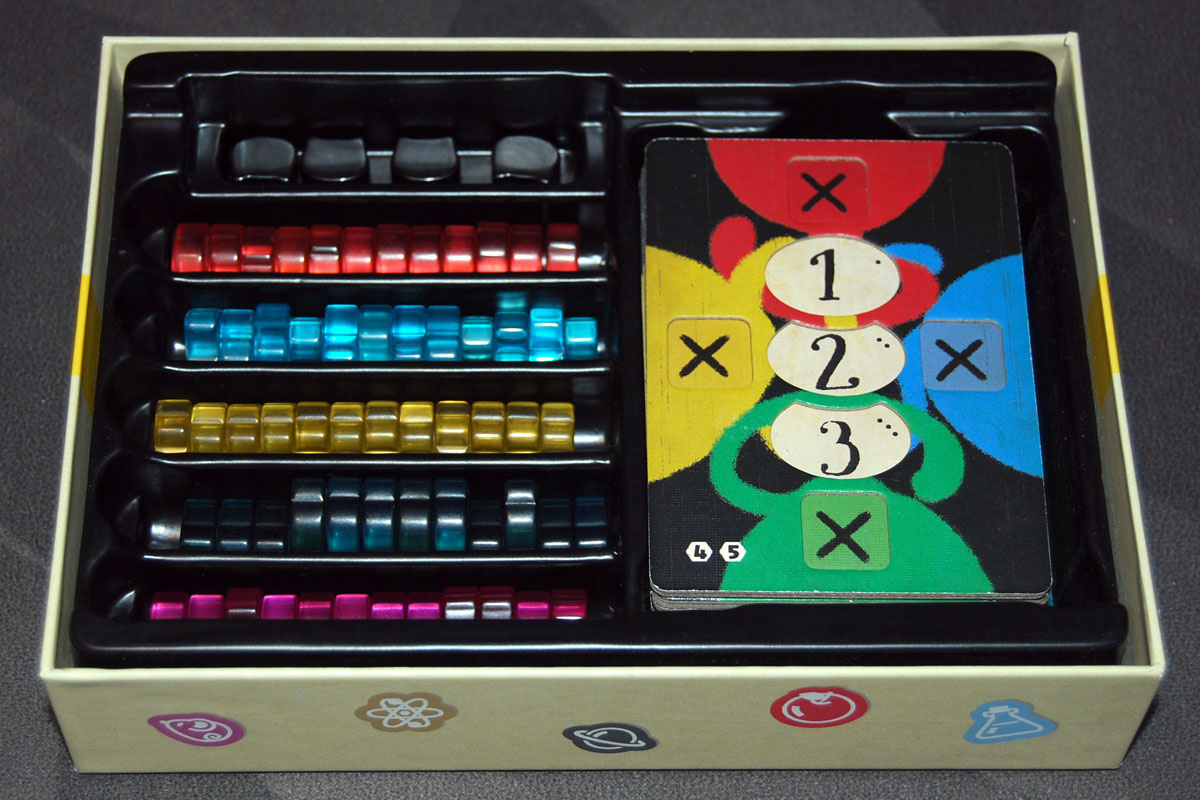
The whole thing comes in a fairly compact box about the size of mass-market paperback novel, and has a nice insert that keeps everything organized.
In terms of color blind accessibility, the player tokens themselves are dual-encoded so they’re identifiable by both shape and color. The cat cards are also fine because they’re all black anyway and you don’t need to be able to identify the color. However, you indicate what color a card is by placing it the corresponding side of your player board—so you could determine a suit by the position of the card, but that could get confusing. Where it may be a bigger a problem is identifying the colors on the research board, connecting a position from a player board to one of the four rows on the research board.
How to Play Cat in the Box
You can download a copy of the rulebook here. Note that the 2-player game uses a slight tweak, so I’ll explain the 3–5 player game first.
Cat in the Box is a trick-taking game, and follows a lot of the classic rules (similar to a game like Spades):
- For each trick, each player will play one card from their hand in turn order.
- You must play a card of the color that started the trick if possible—this is called “following suit.”
- If you have no card of the starting color, you may play any card.
- The winner is the hand that played the highest trump card (red); if no trumps were played, the winner is the hand that played the highest card of the starting color.
- If you don’t follow suit and don’t play a trump card, then you will not win the trick, regardless of how high your card is.
However, in Cat in the Box, there are some interesting tweaks, the biggest of which is that the color of the cards is not predetermined, but we’ll get to that.
The Goal
The goal of the game is to score the most points by winning tricks, correctly predicting the number of tricks you will win, and claiming areas on the research board.

Setup
Each player chooses a player color and takes all the tokens of that color, along with a player board (set to the side for the correct player count). Place one token on each “X” space on your player board.
The research cards are placed in the research board—the side used depends on the player count and player experience. For some player counts, you will use the observed tokens to cover up some of the spaces.
Set up the deck of cat cards based on the player count. For instance, you use all the cards in a 5-player game, but only values 1–8 in a 4-player game. Give the Start Player card to the player who most recently encountered a cat.
Gameplay
You will play a number of rounds equal to the number of players. Each round has a preparation phase, a trick phase, and a scoring phase.
Preparation Phase: Shuffle the cat cards and deal them out evenly to all players. Each player looks at their hand of cards and removes one card, placing it face-down near the research board.
Then, in turn order, each player predicts how many tricks they will win this round, placing a player token on their player board in the appropriate space. Note that you may only choose from the numbers on your board.
Trick Phase: This is the bulk of the game. You will play a series of “tricks” until either everyone has only 1 card left, or when a paradox occurs.
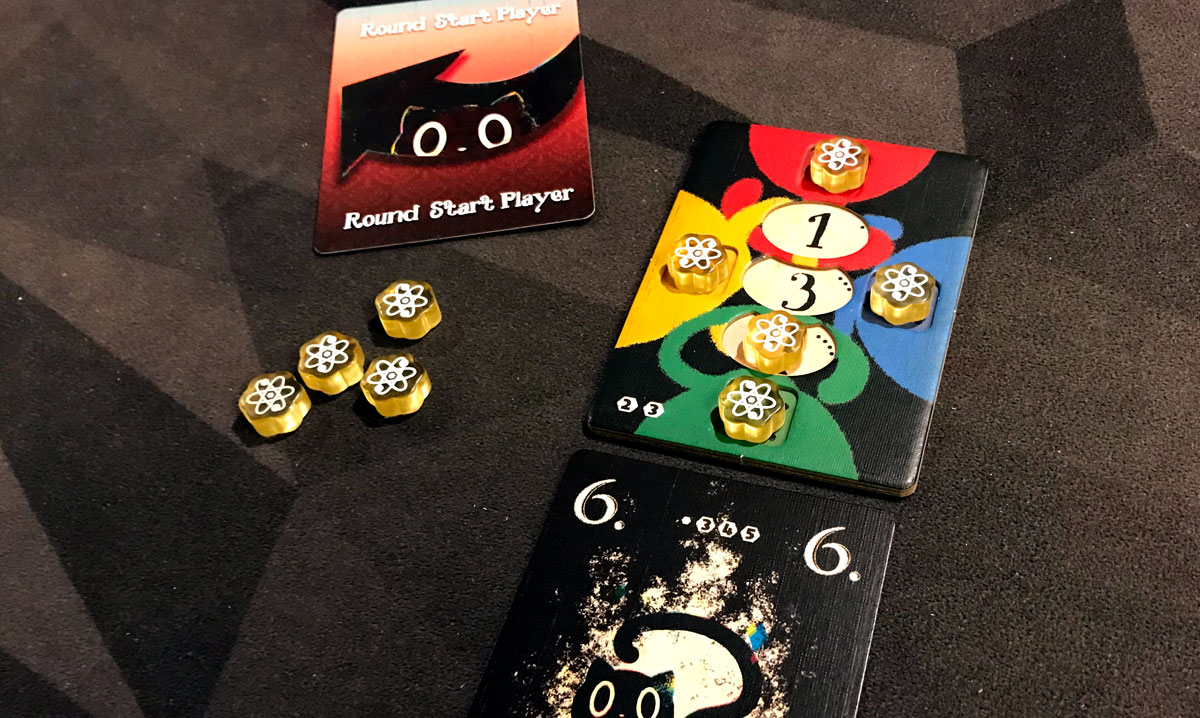
The start player plays a card from their hand, placing it next to their player board to declare its color. (For instance, if you play it at the top of your player board, it is red, but if you play it on the right side of your board, it is blue.) They then place a player token on the research board on the space matching their card’s number and color. Note that you cannot declare a color if its space on the board is already taken! You also may not declare red, the trump suit, unless there is at least one player marker in the red row on the research board or if you have run out of other colors (more on this in a moment).
In turn order, the other players will play cards, declaring the colors in the same way and marking them on the research board. You may declare any color you want. However, if you do not play a card of the same color as the start player, then you must remove the token from the “X” space for that color, indicating that you have no more cards of that color. For the rest of the round, you may not declare any cards to be that color.
After each player has played a card, the winner of the trick is the player with the highest red card; if no red cards were played, then it is the player with the highest card in the color that started the trick. The winner takes all of the played cards and sets them in a scoring pile, and then starts the next trick.
The trick phase continues until you have only 1 card left. The card is discarded and the phase ends.
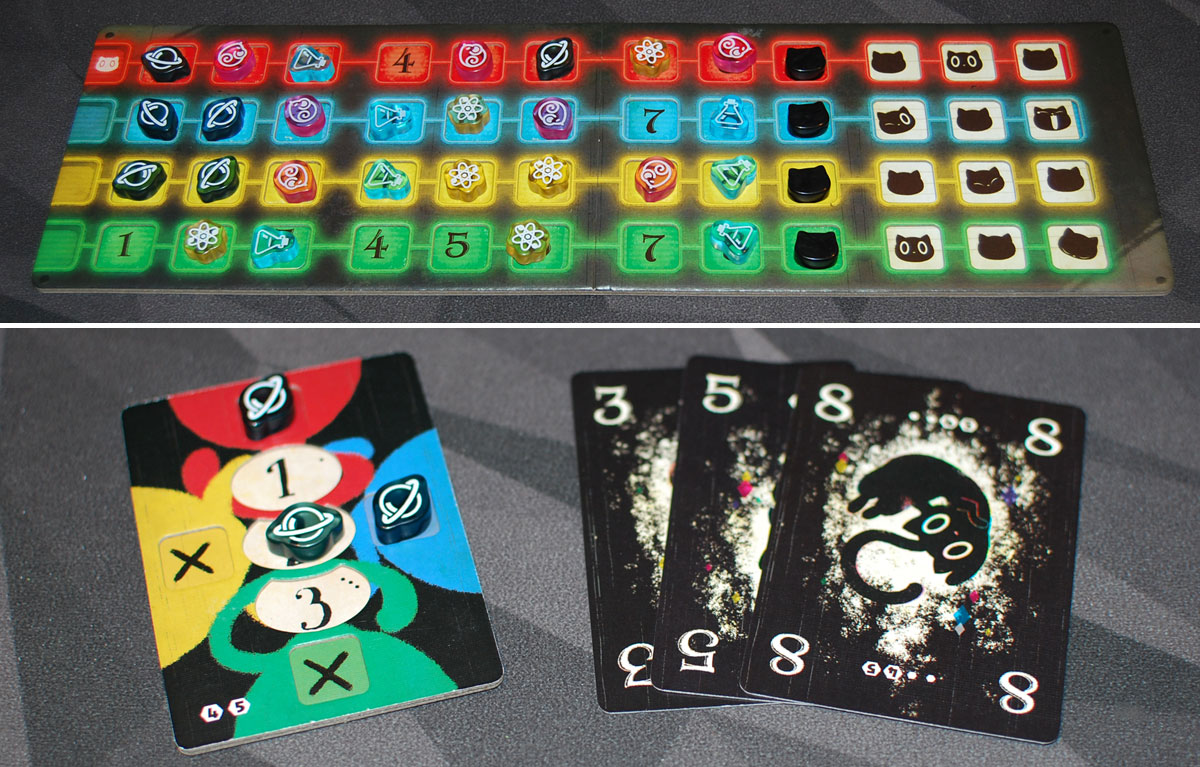
If, during your turn, you are unable to play a card for any reason—the numbers you have left are already marked on the research board, or you cannot claim a color because you already “ran out” earlier in the round—then you have caused a paradox and the trick phase ends immediately, in the middle of that trick. You must reveal your hand if you caused a paradox—you may not intentionally choose to cause a paradox if you have cards that could be played.
Scoring Phase: If a player caused a paradox, that player loses one point for each trick they won this round and do not score any bonus points.
Everyone else scores 1 point for each trick they won.
If you won the number of tricks that you predicted, you get bonus points: find the largest contiguous group of your player tokens on the research board (connected orthogonally, not diagonally), and score 1 point per token in that group.

At the end of the round, all the cards are gathered back up, the tokens are removed from the research board, and each player replaces their player tokens on the “X” spaces on their player cards. The Start Player card is passed clockwise, and a new round begins.
Game End
The game ends after each player has been start player once. The player with the highest score wins, with ties going to the player with the highest score in the final round.
2-Player Rules
For 2 players, you deal 10 cards to each player and set aside the remaining 5. Turn 3 of those face-up and block the revealed numbers on the research board in the green row using a neutral color. If there are duplicates, you move upward toward the yellow row, then blue. These spaces are occupied and cannot be declared.
You do not predict the number of tricks—if you win 4 or fewer tricks during a round, you are eligible for the bonus points.
Cat in the Box is a 2022 GeekDad Game of the Year Finalist!
Why You Should Play Cat in the Box
Cat in the Box is like a traditional trick-taking game crossed with a fun thought experiment: what if your cards were whatever suit you wanted them to be? Sure, you still have to play the numbers you’ve been dealt, but maybe you can just decide that, hey, all of them are the trump suit. That should help you win all the tricks, right?
Well, not so fast. Even though the colors of the cards aren’t predetermined, the one hard-and-fast rule is that each unique card can only be played once per round. There aren’t any duplicates. (Funny, in a game where all the cards are the same color, right?) If you’ve already played the green 7, then that means I can’t play a green 7 without creating a paradox. So then the question becomes, how far can you push things before they break?
In most trick-taking games, you have to follow suit if you can—you can only play something else if you’ve run out. In Spades, nobody is allowed to play a spade card unless spades have been “broken”—that is, somebody has run out of whatever suit was led, and played a spade instead. Since spades are the trump suit, you really want to run out of a suit quickly so that you can play a trump when other players aren’t able to. It can allow you to win tricks even with low numbers. The same is true in Cat in the Box—you could win tricks with low numbers if they’re red and you’ve run out of the starting color. The temptation, of course, is that you get to decide when you’ve “run out.”
So what keeps everyone from having an entire hand full of trump cards? The penalty of a paradox. Instead of getting points per trick, you lose 1 point per trick if you cause a paradox. If you decide that you’re out of blue cards so you can play something else even if you could have claimed a blue spot on the research board, that just means that sooner or later you might find that you have cards left in your hand that can no longer be played.
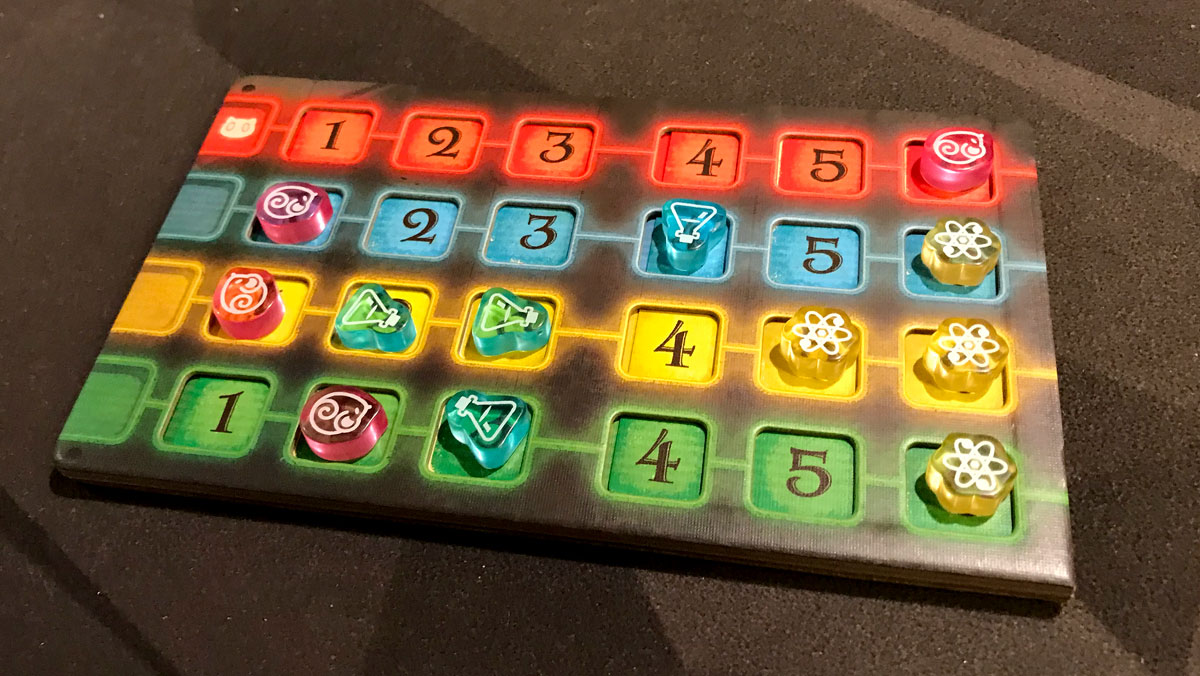
Cat in the Box gives you some further incentive to “run out” of a suit early because of the area control aspect. You want to make a big, connected group of your tokens on the research board. Having several cards of the same value, or having a consecutive run can help with that, but you’ve got to be the first player to claim those spots. There are times when it may be worth declaring that you’re out of a color simply to fill in a crucial connecting point on the board. Of course, making a huge connection doesn’t matter if you don’t correctly predict the number of tricks you will win, and that can take a bit of practice if you’re new to trick-taking games. (Or, I’ve successfully used this strategy: I bid low, but then just won as many tricks as I could without paying any attention to making the contiguous group. Other players, who may have played less aggressively in order to make connections on the board, missed their targets and didn’t score any bonus points, so I got away with my 1-point-per-trick score.)
Even if nobody “cheats” by running out of a suit early, it’s still possible for there to be a paradox, and that’s because Cat in the Box sneakily included five of each number. That’s right: there are only four colors, so it can feel like a game of musical chairs if you see a particular value start filling up on the research board. At the beginning of the round, each player discards one card, and at the end of the round you’ll have one left—so there is a bit of wiggle room provided, but not much. If you’re dealt three 8s and decide to keep all of them because you think you’ll win more tricks that way, don’t be surprised when you discover that the other two 8s are also in circulation.
The difference between the two sides of the research cards is whether the numbers line up or are staggered. On the white (easy) side, you can make a contiguous group by having several cards of the same value. But on the purple side, the numbers are in diagonal lines, so you need some sequences to be able to make those connections. It’s a small difference, but makes it a bit more of a puzzle to decide how you want to play your cards.
Overall, I’ve been delighted with Cat in the Box. I like the way the trick-taking primarily uses classic rules without a lot of tweaks, but also the challenge that the indeterminate colors add to the game. In that sense, it reminds me a little of Time Chase, another game that uses classic trick-taking but adds one significant twist. This is one that I could see myself playing with my extended family, who have experience with traditional card games but don’t always play some of the heavier hobby games, but I’ve also been enjoying it with my regular gaming group as well.
For more about Cat in the Box, visit the Bezier Games website.
Click here to see all our tabletop game reviews.
![]() To subscribe to GeekDad’s tabletop gaming coverage, please copy this link and add it to your RSS reader.
To subscribe to GeekDad’s tabletop gaming coverage, please copy this link and add it to your RSS reader.
Disclosure: GeekDad received a copy of this game for review purposes.
